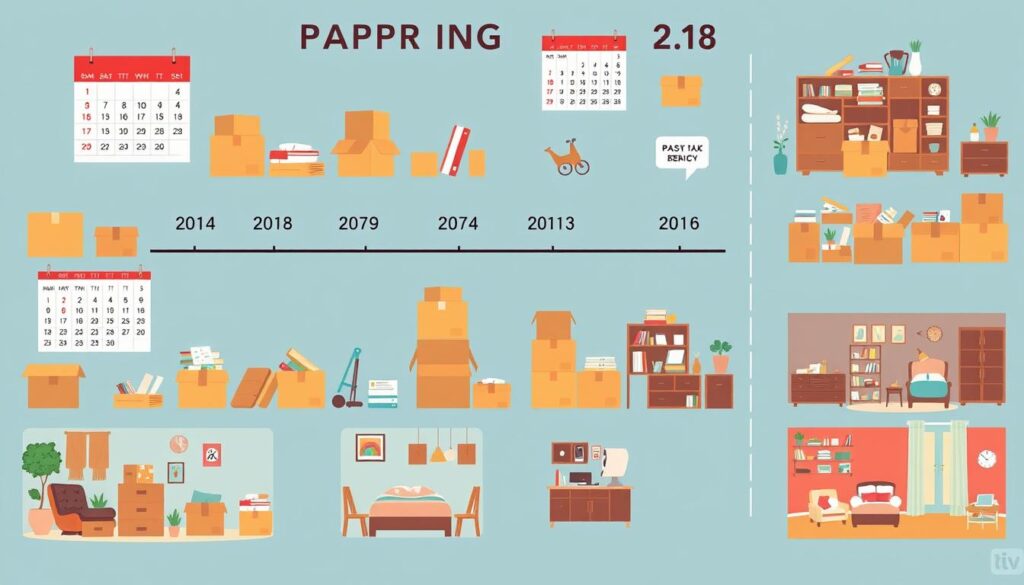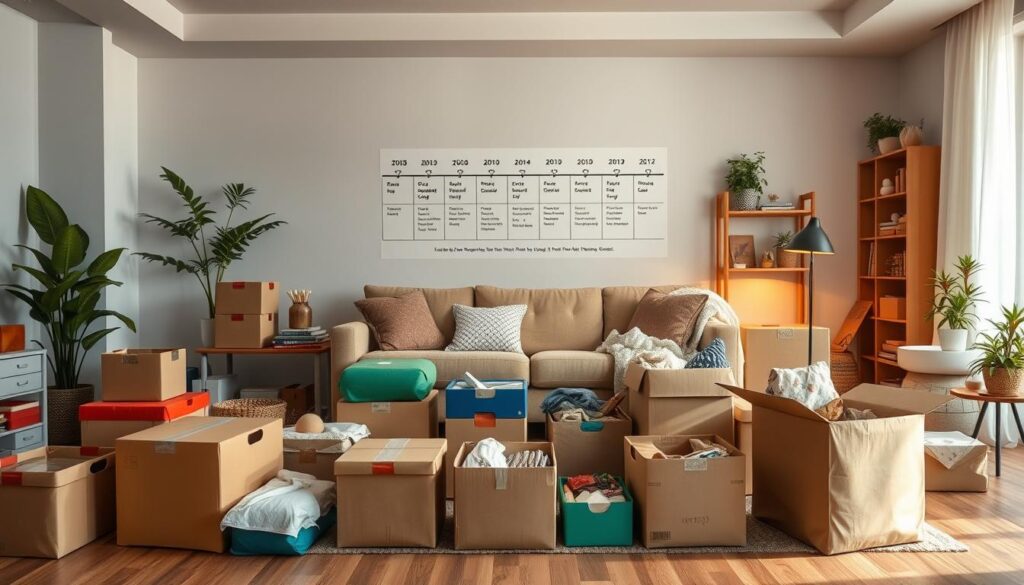How many days does it take to pack an apartment?
Get Your Free Moving Estimate
When considering a move, one of the key questions we often face is, “how many days does it take to pack an apartment?” The time it takes can vary significantly depending on several factors, including the size of the apartment, the amount of belongings, and the efficiency of our packing strategies. Here at HeavenlyMove, we draw on our 20 years of experience and over 35,000 successful moves to provide insights into establishing a timeline that works for you. Typically, the average packing time ranges from three to seven days, but understanding your unique circumstances will help us establish a more precise estimate of the packing duration for your apartment move.
Key Takeaways
- The duration to pack an apartment can range from three to seven days.
- Factors influencing packing time include apartment size and the number of belongings.
- Efficient packing strategies can significantly reduce packing duration.
- Understanding your specific needs helps in creating a tailored packing plan.
- HeavenlyMove offers expert guidance based on extensive moving experience.
Understanding the Packing Timeline
To embark on a successful move, grasping the apartment packing timeline becomes crucial. Several factors directly influence how long this undertaking will take. Understanding these elements allows for a more precise estimate for packing an apartment, ultimately leading to an effective apartment packing schedule.
Factors Affecting Packing Time
Several key aspects can impact how quickly we pack an apartment:
- Number of rooms: More rooms typically mean more items to pack.
- Types of items: Fragile items, large furniture, or priceless collections often require extra time and care.
- Packing pace: Individual preferences and multitasking capacity can vary widely.
Comparing Different Apartment Sizes
Apartment size plays a significant role in determining the overall packing timeline. For instance:
| Apartment Size | Estimated Packing Time |
|---|---|
| Studio | 1-2 days |
| 1-Bedroom | 2-3 days |
| 2-Bedroom | 3-5 days |
| 3-Bedroom | 5-7 days |
The Importance of Organization
Staying organized can dramatically enhance our packing experience. By categorizing items in advance and creating a strategic plan, we foster an efficient apartment packing timeline that minimizes stress. A relevant apartment packing schedule helps ensure nothing is overlooked during the moving process.
Preparing for the Move
Getting ready for a move is crucial for a seamless transition to your new place. Efficient packing preparation can streamline the process, making it less overwhelming. One of the best apartment packing strategies involves creating a comprehensive packing checklist.
Creating a Packing Checklist
A detailed checklist helps us monitor the packing process, ensuring we don’t overlook any items. By breaking down tasks, we can identify which items need to be packed first and which can wait until later. This organized approach can significantly reduce the apartment moving packing time.
Gathering Packing Supplies
Having the right packing supplies on hand is essential for protecting belongings during the move. Basic supplies include:
- Boxes of various sizes
- Bubble wrap
- Packing tape
- Markers for labeling
These supplies not only assist in efficient packing preparation but also help maintain order as we pack different areas of the apartment.
Setting a Moving Date
Deciding on a moving date is a vital step in our packing process. A set date allows us to plan our packing schedule and allocate sufficient time for each room. This preparation ensures that we can complete our apartment packing strategies well before the moving day arrives.
Efficient Packing Strategies
Implementing strategies for efficient packing can greatly influence the packing duration for an apartment move. By adopting a systematic approach, we can enhance our apartment packing speed while ensuring every item is accounted for.
Packing Room by Room
One effective method involves packing room by room. This focused approach prevents us from feeling overwhelmed and allows us to track progress clearly. We recommend the following steps:
- Start with less frequently used rooms, such as storage or guest rooms.
- Move to rooms that are essential, like the kitchen and living room, closer to the moving day.
- Pack furniture last to avoid clutter while packing other items.
Utilizing Packing Techniques
Employing various packing techniques for apartments can save both time and space. Techniques like rolling clothes instead of folding them can optimize space in boxes and speed up the packing process. Additionally, use small boxes for heavier items to make lifts easier and quicker.
Labeling Boxes for Easy Identification
Labeling boxes is crucial for easy identification, which significantly enhances our apartment packing speed during the unpacking phase. Consider these labeling tips:
- Use clear and bold markers to write contents on the sides of boxes.
- Color-code boxes for each room for quick identification.
- Number boxes and create a corresponding inventory list to easily track items.
| Packing Technique | Description | Benefits |
|---|---|---|
| Room by Room | Pack one room completely before moving to the next. | Reduces overwhelm, ensures organization. |
| Rolling Clothes | Roll clothing instead of folding. | Saves space, reduces wrinkles. |
| Labeling | Clearly label all boxes with contents and destination room. | Simplifies unpacking and minimizes searching. |
Estimating Time for Packing
Understanding the apartment packing timeline can help streamline the moving process significantly. Knowing how long to pack each room based on its contents and size is essential for an efficient move. Different areas of the apartment require varying amounts of time, so let’s break it down.
How Long for Each Room?
A well-structured packing timeline is key for efficiency. Here’s an overview of how much time you might expect to allocate for each room:
| Room | Estimated Time Required |
|---|---|
| Living Room | 4-6 hours |
| Bedroom | 2-4 hours |
| Kitchen | 6-8 hours |
| Bathroom | 1-2 hours |
| Dining Room | 2-3 hours |
Time Management Tips
Effective time management for packing is crucial. Implement these strategies to maximize efficiency:
- Set daily packing goals to avoid overwhelming yourself.
- Use a timer to keep track of how long you spend on each room.
- Prioritize your packing tasks to focus on essential items first.
The Role of Help from Friends or Movers
Enlisting help can dramatically influence your packing timeline. Friends or professional movers can speed up the process significantly:
- Friends can assist with heavy lifting and organization.
- Professional movers have experience and resources that streamline packing.
- Coordinate schedules to ensure everyone is available when needed.

Overcoming Packing Challenges
Packing an apartment often presents various challenges that require careful planning and execution. Large furniture, fragile items, and valuable collections demand specific attention to ensure a smooth moving process.
Handling Large Furniture
When it comes to large pieces of furniture, effective preparation can make a significant difference. Consider the following furniture moving tips:
- Disassemble items whenever possible to make transportation easier.
- Utilize moving blankets to protect surfaces from scratches and damage.
- Measure doorways and hallways in advance to avoid complications during the move.
Dealing with Fragile Items
Packing fragile items requires a gentle touch and extra caution. To effectively manage these delicate belongings, follow these tips:
- Wrap each item securely with bubble wrap before placing it in a box.
- Clearly label boxes containing fragile items to alert everyone involved in the move.
- Use sturdy boxes that can support the weight of the items without breaking.
Managing Valuable Collections
Safeguarding valuable collections can be a daunting task. Consider the following strategies:
- Handle collections with care, ensuring they do not rub against each other.
- Consider obtaining insurance for additional peace of mind during the move.
- Keep an inventory of all valuable items, documenting their condition before packing.
Last-Minute Packing Tips
As we approach moving day, employing effective last-minute packing strategies can significantly ease stress and improve efficiency. A solid plan helps ensure that essential items are at our fingertips right when we need them.
Prioritizing Essential Items
Identifying essential packing for moving should be our first task. Focus on necessities for the initial days at our new home. Consider including:
- Clothes and toiletries
- Important documents
- Basic kitchen items
- Chargers for electronics
Packing a Survival Kit
Creating a packing survival kit is a practical step. This kit should contain items we can’t access easily during the transition. Essential components might include:
- First aid supplies
- Snacks and bottled water
- Flashlights and batteries
- Any medications needed immediately
The Night Before the Move
On the evening before move day, we need to focus on final checks. Review and ensure all our items are securely packed. The following evening before move tips can help us get ready:
- Double-check the essential packing list
- Load the car with items for easy access
- Get a good night’s sleep for an energetic moving day
Hiring Professional Movers
When planning a move, we often consider the significant impact of hiring moving professionals. With experience and expertise, these experts streamline the entire moving process, making it less stressful and more efficient.
Benefits of Hiring Experts
Choosing to hire professional movers brings numerous advantages. Some key benefits include:
- Expertise in packing: Well-trained movers handle items of all types, ensuring everything is safely packed.
- Time-saving: Professionals work efficiently, allowing us to focus on other aspects of the move.
- Safety: Reducing the risk of injuries by having trained movers lift and transport heavy items.
Cost Considerations
Understanding moving cost estimates is crucial for budgeting. Costs can vary based on:
- Distance of the move.
- Volume of items being moved.
- Special services required, such as packing or storage.
Transparent pricing from reputable companies ensures no hidden fees, helping us stick to our financial plans.
Scheduling and Coordination
Effective scheduling and coordination play vital roles in a successful move. We should consider:
- Booking movers in advance, especially during peak seasons.
- Planning around our personal schedules and availability.
- Ensuring a clear communication line with the moving team for updates and adjustments.
| Service Offered | Cost Estimation (Average) |
Time Required |
|---|---|---|
| Local Move | $500 – $2,000 | 3 – 8 hours |
| Long-Distance Move | $2,000 – $5,000 | 1 – 5 days |
| Packing Services | $200 – $1,000 | Varies based on volume |
Unpacking Strategies
After a successful move, we focus on unpacking efficiently to make our new apartment feel like home. This process begins by establishing a comfortable environment and systematically placing our belongings. By adopting effective unpacking strategies, we simplify our transition into the new space, enhancing both comfort and usability.
Setting Up a New Space
Setting up a new apartment often revolves around the essentials. We prioritize unpacking items that will be immediately useful, such as kitchen utensils, toiletries, and bedding. This approach minimizes the chaos and allows us to enjoy our space sooner.
Organizing Boxes Post-Move
Organizing after move involves tackling one room at a time. We can use a systematic approach:
- Start with the most used areas: kitchen, bathrooms, and bedrooms.
- Unbox similar items together, grouping them by function or location.
- Labeling boxes helps us track where everything goes, making the unpacking feel less overwhelming.
This organized methodology ensures that each room quickly becomes functional and inviting.
Creating a Functional Environment
Creating a functional environment requires thoughtful placement of furniture and decor. We consider factors like flow and natural light when designating spaces for each item. Furthermore, it’s beneficial to arrange items based on how we intend to use them, ensuring everything is within easy reach. By focusing on functionality, we increase overall satisfaction and comfort in our new apartment.

What to Expect on Moving Day
Moving day represents a culmination of preparation, characterized by various tasks that can influence our overall experience. Understanding moving day expectations can significantly lessen anxiety and allow us to focus on what to do on moving day.
Final Packing Touches
Before loading up the moving truck, ensure everything is securely packed. This includes:
- Double-checking boxes for fragile items
- Labeling each box clearly for easy identification
- Securing any loose items or furniture
These final packing touches can prevent last-minute surprises and ensure a smoother transition to your new home.
Coordinating with Movers
Effective communication is crucial when working with movers. Share your moving day expectations regarding the timeline and specific needs. Here are essential points to consider:
- Provide detailed instructions about which items need special handling
- Establish a clear pickup location
- Discuss the layout of the new place for placement of items
Properly coordinating with movers allows for a more organized process and can greatly reduce moving stress.
Managing Stress Levels
Reducing moving stress is essential for an enjoyable moving day experience. Implementing practices such as:
- Deep breathing exercises during hectic moments
- Staying hydrated with plenty of water
- Taking short breaks to recharge
These strategies not only help keep anxiety at bay but also create a more positive atmosphere as we tackle this big day together.
Adjusting to Your New Apartment
Moving into a new apartment brings excitement along with its own set of challenges. Adjusting to your new apartment involves familiarizing yourself with the space while making it feel like home. We can ease this transition through practical strategies and by engaging with our surroundings.
Tips for Settling In
Unpacking and arranging belongings thoughtfully can significantly contribute to our comfort. Incorporating personal touches can create a space that reflects our identity. Consider these settling in tips:
- Unpack essential items first to streamline daily routines.
- Organize spaces to promote functionality and comfort.
- Incorporate familiar decor, such as photographs or artwork.
Building a Routine
Establishing a routine is crucial for maintaining a sense of normalcy. A balanced daily schedule fosters organization and reduces stress, making adjusting to new habits easier. Key elements of a beneficial routine might include:
- Setting regular meal times to promote healthy eating.
- Designating time for exercise to enhance well-being.
- Cultivating relaxation practices to recharge at the end of the day.
Meeting Neighbors
Building community in a new area can transform our experience. Meeting neighbors creates valuable social connections, contributing to a sense of belonging. Ways to engage with the community include:
- Hosting a small gathering to introduce ourselves.
- Participating in local events and activities.
- Friendly conversations during shared spaces, like laundry rooms or hallways.
This period of transition offers a chance to not only establish a living space but also to form new relationships and rhythms in our lives. Embracing these aspects can lead to a fulfilling experience in our new apartment.
Common Mistakes to Avoid
During the packing process, we often encounter challenges that can hinder our moving efforts. Recognizing and addressing mistakes when packing helps ensure a smoother transition to your new space. By taking a closer look at common pitfalls, we can effectively prepare and execute our packing strategy.
Procrastination Pitfalls
Many people find themselves delaying their packing duties, which leads to unnecessary stress and disorganization. Procrastination can increase chaos as the moving day approaches. We advise setting a clear timeline and sticking to a schedule to avoid packing errors that stem from last-minute activities.
Overpacking Boxes
Another prevalent issue involves overpacking boxes. While it might seem logical to fit as much as possible into each container, this practice can result in heavy, unwieldy boxes that are difficult to lift and transport. To avoid packing errors, we suggest adhering to weight limits and using multiple boxes for different items. This way, we can ensure easier handling and minimize the risk of damage.
Underestimating Time Needed
Many individuals significantly underestimate the time required for packing. Rushing to finish tasks leads to potential mistakes when packing, from forgetting essential items to compromising on the careful wrapping of fragile belongings. Creating a realistic timeline, accounting for packing demands, helps us navigate this common moving pitfall more effectively.
| Mistake | Consequence | Solution |
|---|---|---|
| Procrastination | Last-minute chaos | Create a schedule |
| Overpacking | Heavy boxes | Distribute weight evenly |
| Underestimating time | Inadequate preparation | Set realistic deadlines |
Conclusion
In wrapping up our discussion, it’s essential to revisit some key packing tips that can significantly ease your transition. Effective organization—such as creating a packing checklist and gathering essential supplies—will streamline your moving process. Additionally, utilizing professional assistance can take your packing efficiency to the next level, ensuring everything is handled with care.
Recap of Key Packing Tips
Throughout this article, we’ve outlined various strategies that simplify your moving experience. Thorough planning, room-by-room packing, and prioritizing essential items are just a few components that lead to a smooth moving process. Remember, the right packing techniques and a little help from experts can transform what might feel like a daunting task into an organized endeavor.
Encouragement for a Smooth Move
We encourage everyone to embrace the journey of moving, focusing on the excitement of a new chapter. With careful preparation and the application of our packing efficiency insights, you can reduce the stress associated with moving day. Trust in our experienced team to manage the heavy lifting, allowing you to fully enjoy the process of settling into your new home.
Final Thoughts on Packing Efficiency
Ultimately, by employing the strategies discussed and seeking assistance when needed, you can achieve a successful move and create a welcoming environment in your new living space. Embrace this opportunity to start fresh, as your organized packing efforts will pave the way for a smooth transition into your future.


